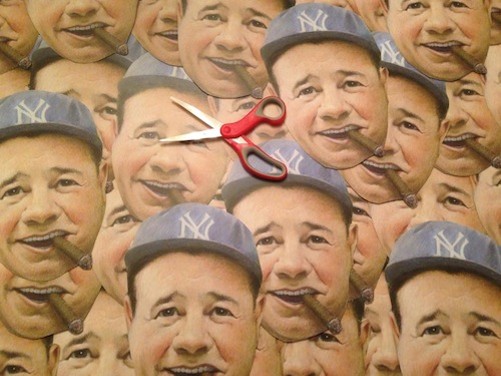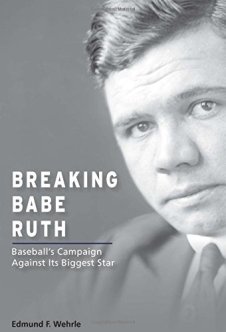
The book: “Gehrig & the Babe: The Friendship and the Feud”
The author: Tony Castro
How to find it: Triumph Books, 304 pages, $25.95, released April 1
The links: At Amazon.com, and the publisher’s website.
 The reviews in 90-feet or less: A year ago, a kid from Simi Valley gave us all some strange insight on the Ruth-Gehrig dynamic.
The reviews in 90-feet or less: A year ago, a kid from Simi Valley gave us all some strange insight on the Ruth-Gehrig dynamic.
Our first book of the 2017 reviews – “The Boy Who Knew Too Much: An Astounding True Story of a Young Boy’s Past-Life Memories” — was focused on Christian Haupt, an 8-year-old whose mom has come to believe he was re-incarnated as Gehrig.
It started with him, before age 4, telling her about how he didn’t get along with The Bambino. She didn’t know what he was talking about until she did some research and found out that, yes, that’s been written about. But how did her son even know all that?
So now coming up on 70 years since Babe Ruth’s passing, one might wonder if he, too has pulled some “Field of Dreams” deal risen from underneath his plaque in Yankee Stadium center field and suddenly come to life.
He is, at least, in another round of hard- and soft-bound literature.
 By the time October falls into place, Jane Leavy will be staking her reputation on another baseball bio epic called “The Big Fella: Babe Ruth and the World He Created,” and part of the blurb for it calls it “the definitive biography” of the man who “drafted the blueprint for modern athletic stardom.”
By the time October falls into place, Jane Leavy will be staking her reputation on another baseball bio epic called “The Big Fella: Babe Ruth and the World He Created,” and part of the blurb for it calls it “the definitive biography” of the man who “drafted the blueprint for modern athletic stardom.”
 Spinning off that concept, there’s “Babe Ruth and the Creation of the Celebrity Athlete,” by Thomas Barthel, due out now in June. The author here wants to separate “exaggerated facts from clear falsehoods” and trace “Ruth’s ascendance as the first great media-created superstar and celebrity product endorser.”
Spinning off that concept, there’s “Babe Ruth and the Creation of the Celebrity Athlete,” by Thomas Barthel, due out now in June. The author here wants to separate “exaggerated facts from clear falsehoods” and trace “Ruth’s ascendance as the first great media-created superstar and celebrity product endorser.”
 Around that same time, “The Age of Ruth and Landis: The Economics of Baseball during the Roaring Twenties,” by David George Surdam and Michael J. Haupert will also appear. It claims to cover a “tumultuous 1920s” guided by these two legends, as well as Rogers Hornsby, Ty Cobb, Walter Johnson, Tris Speaker and Eddie Collins, to where there was now “an exciting brand of livelier baseball, new stadiums, and overall stability.”
Around that same time, “The Age of Ruth and Landis: The Economics of Baseball during the Roaring Twenties,” by David George Surdam and Michael J. Haupert will also appear. It claims to cover a “tumultuous 1920s” guided by these two legends, as well as Rogers Hornsby, Ty Cobb, Walter Johnson, Tris Speaker and Eddie Collins, to where there was now “an exciting brand of livelier baseball, new stadiums, and overall stability.”
 And then there’s “Breaking Babe Ruth: Baseball’s Campaign Against Its Biggest Star,” by Edmund F. Wehrle, for Sports and American Culture series, due out May 31. The author is said expose how Ruth was “an ambitious, independent operator, one not afraid to challenge baseball’s draconian labor system,” and this perspective will paint Ruth “more seriously and placing his life in fuller context (which is) is long overdue.”
And then there’s “Breaking Babe Ruth: Baseball’s Campaign Against Its Biggest Star,” by Edmund F. Wehrle, for Sports and American Culture series, due out May 31. The author is said expose how Ruth was “an ambitious, independent operator, one not afraid to challenge baseball’s draconian labor system,” and this perspective will paint Ruth “more seriously and placing his life in fuller context (which is) is long overdue.”
That’s almost, but not quite, equal to the number of nicknames George Herman Ruth amassed in his 53 years on the planet.
To tie us down for now, we have this Castro book to digest, which can be just as fulfilling as a pile of hot dogs chased down with a vodka and tonic.
The L.A.-based former Herald Examiner columnist who already authored “Mickey Mantle: America’s Prodigal Son” and “DiMag & Mick: Sibling Rivals, Yankee Blood Brothers” decides that this Ruth-Gehrig relationship is worthy of a excavation.

He starts with a compelling place: Ruth being asked to be in Hollywood to participate in the “Pride of the Yankees” Gary Cooper movie, which celebrated its 75th year in 2017 and was chronicled in a Richard Sandomir book last summer. Castro writes in his bibliography that he uses the Sandomir book — as well as the soon-to-be-released Leavy story. Which is kind of strange, referencing a book that hasn’t come out yet.
Castro’s most unlikely source for this turns out to be Johnny Grant, who’d go on to become known as the Mayor of Hollywood and the Hollywood Walk of Fame master of ceremonies. As a teenager crashing the set, Grant befriends Ruth during the movie shoot and becomes an odd sounding board for Ruth’s emotional delayed grief over Gehrig’s passing.
 “I let my friend down,” Ruth cries to Grant (right) at a time when he could probably sense his time on Earth was coming to a close sooner than later. He tells Grant it all came down to women.
“I let my friend down,” Ruth cries to Grant (right) at a time when he could probably sense his time on Earth was coming to a close sooner than later. He tells Grant it all came down to women.
“It’s always broads, keed. Friends shouldn’t part of broads but they do all the time. …
“I just never thought I would miss him this much.”
And who knew Grant would have an noncredit role as a reporter in “The Babe Ruth Story” a few years later.
Even if you think you’ve read every Ruthian account of the man’s life, Castro’s rhythmic craftsmanship makes it crisp and engaging, piecing together previous accounts but with a eye for what may or may not have been responsible for their eventual rift.
We already could sense that their two different personalities would clash, but what perhaps made this the Kobe Bryant-Shaquille O’Neal pairing of their day was that, as Castro writes, “the legend of Ruth operated at the intersection of reality and absurdity,” while Gehrig is quoted at the top of Chapter 11 on page 141: “It’s a pretty big shadow (cast by Ruth). It gives me a lot of room to spread myself.”
A more in-depth look at “The Feud” doesn’t come until Chapter 16, given that title, on page 199.

Although, as Ruth says, women did play a large role, we didn’t really know he was implying that it was Gehrig’s mom, who often doted too much on Ruth, eight years older than Lou. But she also would make judgmental comments about Ruth’s daughters that got back to him.
Gehrig’s wife, Eleanor, also comes into play. Was she having some kind of affair with Ruth? Oh, please. But that’s something that came up as well.
Considering the huge impact these two No. 3 and No. 4 teammates had not just on the sport but in history, a book about their relationship is warranted because of how it gives us more of their insecurities and dispositions.
We’d like to believe it was always a good partnership, especially those barnstorming trips after each season. But now maybe we know better.
 How it goes down in the scorebook: In retrospect, and using Castro’s opening scene as a reference point, consider how Ruth and Gehrig were portrayed by Hollywood in biopics. William Bendix (1948), John Goodman (1992) and Stephen Lang (1991) pretty much failed in their portrayal of Ruth (as the RottenTomatoes.com will attest). But Cooper (1942) created almost an Oscar-worthy deity with Gehrig, where we aren’t even sure if Gehrig could have lived up to the way Cooper portrayed him. If not for Ruth’s participation in “Pride of the Yankees,” whose to say Ruth didn’t help create those optics by playing himself and making it all seem real.
How it goes down in the scorebook: In retrospect, and using Castro’s opening scene as a reference point, consider how Ruth and Gehrig were portrayed by Hollywood in biopics. William Bendix (1948), John Goodman (1992) and Stephen Lang (1991) pretty much failed in their portrayal of Ruth (as the RottenTomatoes.com will attest). But Cooper (1942) created almost an Oscar-worthy deity with Gehrig, where we aren’t even sure if Gehrig could have lived up to the way Cooper portrayed him. If not for Ruth’s participation in “Pride of the Yankees,” whose to say Ruth didn’t help create those optics by playing himself and making it all seem real.
So, why do Babe Ruth movies not come out as well as they could have? The curse of Gehrig …
Also:
*Ruth is in the news even today. Who owns the bat he used to hit his 60th home run in 1927? We need to know.


2 thoughts on “Day 25 of 30 baseball book reviews for 2018: You’ve still come a long way, Babe, and apparently we can’t get enough of how great thou art”